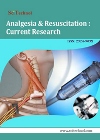About the Analgesia & Resuscitation : Current Research

Analgesia & Resuscitation: Current Research is a peer-reviewed scholarly journal that aims to publish the most complete and reliable source of information on the discoveries and current developments in the form of original articles, full/mini reviews, case reports, commentaries, letter to editor, rapid/short communications, etc. in all areas pertaining to analgesia and resuscitation, making them available online freely without any restrictions or subscription to researchers worldwide.
Scope and Relevance of Analgesia & Resuscitation: Current Research:
- Analgesia
- Anesthesia
- Resuscitation
- Critical care
- Sedation
- Intensive Care
- Emergency Medicine
- Pain Research
- Molecular pain
- Perioperative Care
The journal uses Editorial Tracking System for a qualitative and prompt review process. Review processing is performed by the editorial board membersof Journal of Women's Health, Issues & Care or relevant experts from other universities or institutes. Minimum two independent reviewer’s approval followed by editor approval is required for the acceptance of any citable manuscript. Authors may submit manuscripts and track their progress through the editorial system. Reviewers can download manuscripts and submit their opinions to the editor whereas the editors can manage the whole submission/review/revise/publish process via editorial manager.
Submit manuscript at Online Submission System or send as an e-mail attachment to the Editorial Office at submissions@scitechnol.com
*Unofficial 2016 Journal Impact Factor was established by dividing the number of articles published in 2014 and 2015 with the number of times they are cited in 2015 based on Google search and the Scholar Citation Index database. If ‘X’ is the total number of articles published in 2014 and 2015, and ‘Y’ is the number of times these articles were cited in indexed journals during 2016 than, impact factor = Y/X.
Critical Care
Critical care helps people with life-threatening injuries and illnesses by treating problems such as accidents, infections, complications from surgery and severe breathing problems. Critical care usually takes place in an intensive care unit.
Antidepressant Medications
Antidepressant medications are used to treat the persons suffering from mild to severe depression in order to relieve the symptoms, by correcting chemical imbalances of neurotransmitters in the brain.
Sedation
Sedation is defined as reduction of his/her response to the external stimuli i.e; anxiety, depression, irritability, excitement, stress etc. Sedation is caused by sedatives.
Physiological Disorders
A physiological disorder is a condition in which the organs in the body malfunction causes illness. Examples are Asthma, Glaucoma, Diabetes.
Physiological Disorders is normally caused when the normal or proper functioning of the body is affected because the bodys organs have malfunctioned, not working or the actual cellular structures have changed over a period of time causing illness.
Intensive Care
Intensive Care is a special section in the hospital where a group of medically skilled people with special equipments, cares for the patients who are seriously injured.
Emergency Medicine
Emergency medicine is a branch of medicine that deals with evaluation and initial treatment of conditions resulting from trauma or sudden illness. The patient’s condition is stabilized and care is transferred to the primary physician or to a specialist.
Analgesia
Analgesia is the medical treatment used to control the pain. Pain is an unpleasant sensory and emotional experience associated with potential or actual tissue damage. “Analgesics” is the term used for medications which are used for treating pain.
Anesthesia
It is a state of being unconsciousness, in order to free from sensations induced by certain interventions or other painful procedures. “Anesthetics” is the medical term used for medications used for anesthesia.
Resuscitation
Resuscitation is a term describing the process to bring back to life or consciousness of an acutely unwell patient.
Resuscitation should be performed immediately on any person who has become unconscious and is found to be pulse less. Assessment of cardiac electrical activity via rapid “rhythm strip” recording can provide a more detailed analysis of the type of cardiac arrest, as well as indicate additional treatment options.
Pain
A highly unpleasant physical sensation that can range from mild, localized discomfort to agony caused by injury or illness. Pain may be contained to a discrete area, as in an injury, or it can be more diffuse, as in disorders like fibromyalgia. Pain is mediated by specific nerve fibers that carry the pain impulses to the brain where their conscious appreciation may be modified by many factors.
Pain Medicine
Pain Medicine is a discipline within the field of medicine that is concerned with the prevention of pain, and the evaluation, treatment, and rehabilitation of persons in pain. Some conditions may have pain and associated symptoms arising from a discrete cause, such as postoperative pain.
Pain Killer
Pain Killers or Analgesics are the medications used to treat pain. There are different types of pain killers to treat different kinds of pain with different routes of administration. Different kinds of NSAIDS are used as analgesics.
Pain Management
Pain management is the process of providing medical care that reduces analgesia. Pain is complex, so there are many treatment options - medications, therapies, and mind-body techniques. Massage, acupuncture, acupressure, and biofeedback have also shown some validity for increased pain control in some patients.
Anesthesiology
Anesthesiology refers to the branch of medicine that studies how to suppress the perception of pain and sensation in the brain. The scope of anesthesiology includes non-surgery-related pain management; management of painful syndromes; monitoring, restoring, and maintaining hemostasis; teaching CPR; evaluating and applying respiratory therapy.
Pain and Aging
A highly unpleasant physical sensation that can range from mild, localized discomfort to agony caused by injury or illness. It is a major symptom in many medical conditions, and can significantly interfere with a person's quality of life and general functioning. The importance of pain related phenomena is critical in old patients due to multidimensional losses.
Palliative Treatment
Palliative care is the active, total care of the patients whose disease is not responsive to curative treatment. Palliative care is to offer the most basic concept of care – that of providing for the needs of the patient wherever he or she is cared for, either at home or in the hospital.
Pain Research
An increased understanding of the basic mechanisms of pain will have profound implications for the development of future medicines. Investigators working to develop the future generation of pain medications is to formulate compounds that will prevent pain signals from being amplified by the nervous system or to block certain steps in the pain pathway, especially in conditions when there is no injury or trauma.
Molecular pain
Molecular pain is a relatively new and rapidly expanding research field that represents an advanced step from conventional pain research which addresses physiological and pathological pain at the cellular, subcellular and molecular levels.
Neuropathic pain
Neuropathic pain results from damage to or dysfunction of the peripheral or central nervous system, rather than stimulation of pain receptors. Pain can develop after injury to any level of the nervous system, peripheral or central; the sympathetic nervous system may be involved.
Perioperative Care
Perioperative care involves preoperative, intraoperative, and postoperative. It provides better conditions for patients before operation, during operation, and after operation. This period is used to prepare the patient both physically and psychologically for the surgical procedure and after surgery.
 Spanish
Spanish  Chinese
Chinese  Russian
Russian  German
German  French
French  Japanese
Japanese  Portuguese
Portuguese  Hindi
Hindi 


